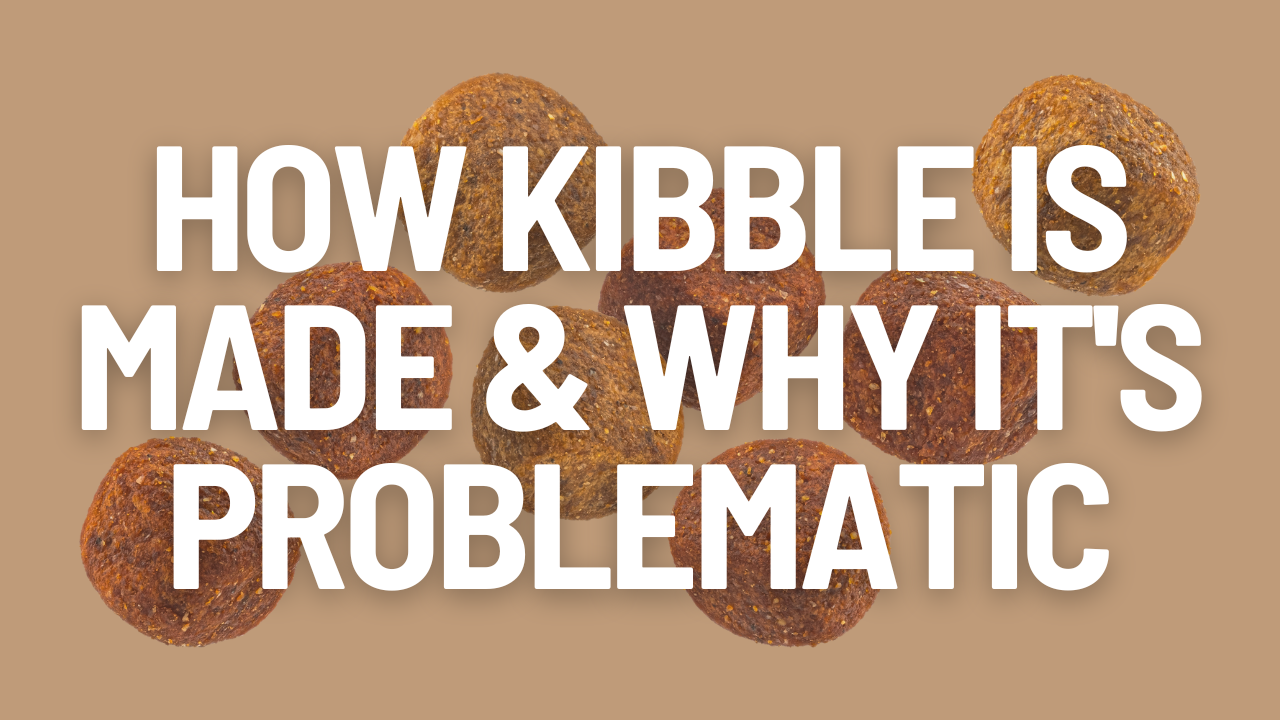ever wondered how kibble was made and if this is truly the best for your dog? Most veterinarians have not been educated on nutrition. They are not nutritionists.
We feed our dogs kibble because it’s easy – but it’s not natural. As humans, we try to avoid highly processed foods, we know they are bad for us. So why would we continue to feed this to our beloved pets?
How Is Kibble Made?
- Ingredient Mixing: Raw materials are collected and combined. These often include meat meals (which are rendered animal parts), grains, vitamins, and minerals.
- Grinding: The ingredients are ground into a fine powder to ensure a consistent texture.
- Pre-Cooking: This mixture is then cooked to a certain extent to break down the carbohydrates and make the ingredients more digestible.
- Extrusion: The cooked mixture is pushed through an extruder, a machine that shapes the kibble by forcing the dough through a die plate. This step uses high pressure and heat, cooking the kibble further.
- Drying: The kibble is dried to remove moisture, which helps in preserving it and extending its shelf life.
- Coating: Fats and flavour enhancers are sprayed onto the kibble to make it more palatable to dogs (since most of the natural taste is gone because of the manufacturing process). This coating often includes oils and animal fats, which can oxidise and turn rancid if not stored properly.
- Packaging: Finally, the kibble is cooled and packed into bags, ready to hit the store shelves.
Why Kibble Can Be Problematic
While kibble is convenient and “cost-effective” (if you buy HQ kibble, it won’t be cheaper than fresh meals), several issues can make it problematic for your dog’s health.
- Nutrient Loss: The high heat and pressure used in the extrusion process can destroy many essential nutrients. Vitamins, minerals, and amino acids may be lost or degraded, and synthetic additives are often used to replace them.
- Low-Quality Ingredients: Not all kibble is made equal. Many commercial brands use low-quality ingredients such as meat by-products, fillers like corn and soy, and artificial preservatives. These can be harder for dogs to digest and don’t provide the best nutrition. They often cause allergies and other health problems, such as organ failure.
- High Carbohydrate Content: Kibble often contains a high percentage of carbohydrates, which are not a natural staple in a dog’s diet. Dogs thrive on high-protein, low-carb diets, and excessive carbs can lead to obesity and other health issues.
- Contamination Risk: There have been numerous recalls of kibble due to contamination with harmful bacteria (like Salmonella) or toxins (like aflatoxins). Manufacturing processes and storage conditions can sometimes fail to prevent these issues.
- Dental Health Concerns: Contrary to popular belief, kibble does not necessarily clean a dog’s teeth. The small, hard pieces can break up quickly in a dog’s mouth, not providing the abrasive action needed to clean teeth effectively. Additionally, the high carbohydrate content can contribute to plaque buildup and dental issues.
- Additives and Preservatives: Many kibbles contain artificial colours, flavours, and preservatives. These chemicals can be problematic for some dogs, potentially leading to allergic reactions or other health issues.
- Storage and Freshness: Once a bag of kibble is opened, the fats and oils can start to oxidise and go rancid. This can decrease the food’s nutritional value and make it less appetising to dogs. Proper storage is crucial to maintain the quality and safety of the kibble.
Conclusion
Kibble has its place in the dog food market due to its convenience and affordability, but it’s important to be aware of its potential drawbacks. Opting for high-quality, well-reviewed brands prioritising natural ingredients and proper nutrient balance can help mitigate some of these issues. Remember that expensive doesn’t always equal good. You need to really look at the label (more on that in next week’s blog).
Additionally, incorporating fresh, whole foods into your dog’s diet, like lean meats and vegetables, can provide additional nutrients and variety that kibble alone may not offer. Remember, every dog is different, and what works for one may not work for another, so always monitor your dog’s health and consult with a vet – or better: a canine nutritionist – when making significant changes to their diet.

